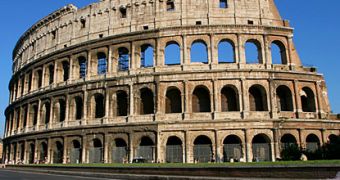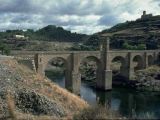They had central heating, baths with all the commodities and bridges and roads that even after two millennia are still functional. The Colosseum could have resisted in perfect stage if it had not been plundered. All was made on stone, timber and...concrete.
From Iraq to Portugal and from Sahara to Romania, Germany and UK the Romans still impress us with their buildings on cement, stone and bricks. The Romans' greatest discovery is the concrete. They built three types of walls with it.
Opus caementicium is based on a mixture of 12 parts of volcanic ash, 9 of lime, 6 of sand and 16 of gravel and stone. After adding water and beating the mixture, it required a time to get solid (forge).
Opus reticulatum is made of triangular stones with a diagonal base.
Opus testaceum was made of flat bricks. There was also opus vittatum, a stonemansory made of small and prismatic stones put in regular lines.
In such a vast empire, rapid communication was vital, that's why the Romans built a network of stone roads connecting the empire's provinces. Their main role was to ease the rapid displacement of the legions, but in time the commercial and cultural importance prevailed.
Over mountains and swamps, crossing rivers and canyons, the Roman engineers built a network of roads that was still used in the 18th century. Only in Spain and Portugal, Romans built 30,000 km (18,000 mi) of roads. The Roman road (via) was built by superposing layers: below - cements with stone pieces (statumen), then a gravel filling (rudus). Over rudus ground there were stones connected through lime. The paving stones were fixed with a lime mortar. When the roads crossed wet areas, the Romans put carbon on the first layer to impede the activity of the microorganisms.
In Spain, Roman aqueducts were still used during the 19th century. Medieval Arabs copied the Roman architecture of the aqueducts.
The secret of the Roman bridges was the Arch. It was known by the ancient Egyptians, Mesopotamians and Greeks, but only the Romans employed its enormous possibilities.
The most primitive bridges were simple boards located over pillars and with the stone it was almost impossible to reach more than 6 m (20 ft) the distance between the supports. The arches allowed reaching greater distances, but one peculiarity had to be solved: an arch is mobile.
The inserted pieces in an arch make its weight decomposed into vertical pushes (the support stands them without problems) and lateral ones, which must be counteracted. An arch only sustains when it is complete. While building, a timber sub-structure must be located for maintaining the curve shape. The arch is ready when the central piece, called the key, is placed.
The Alcantara Bridge between Caceres (Spain) and Coimbra (Portugal), built during the emperor Trajanus in the 2nd century, is still in use. The bridge crosses a canyon of the Tajo River. It has a height of 60 m (200 ft), as tall as a 20 levels block and is made of 6 arches. The width of the central two is of 28 m (93 ft). Only two heaps lean on the river's bed and have a triangular section.
Another (re)discovery of the Romans is the vault. A cupola is nothing more than a semispheric vault. The most impressing Roman vault is the Rome's Pantheon, built between 118 and 125 AD. The horizontal distance between its supporting points is of 43 m (144 ft), a performance which will be achieved again only in the 19th century. The Pantheon survived because it was turned into a Christian church.
They built the walls with different types of concrete: heavier and tougher at the base (mixed with stone) and lighter to the higher levels (with pumice). On the second floor of the cupola (attic) there were false windows decorated with various motifs.
On the top of the cupola there was a skylight, which besides allowing the light entrance it lightened the cupola. The Pantheon's skylight is of 9 m (30 ft).
Greek theaters were carved in one side and open to nature on the other side. But the Roman theaters had a new disposition: they were amphitheaters. The most impressive is the Colosseum, built in 80 AD.
Romans are also the inventors of the triumph arches and commemorative columns. They brought hygiene and dignity in their homes and their mosaics are another contribution.
In 33 AD, there were 33 balneae (bathing establishments) in Rome. In 354 AD, there were almost 1,000. They could be 220x114 m (730x380ft) and could harbor 1,600 persons. There were three main rooms: frigidarium (cold room), tepidarium (temperate room) and caldarium (hot room), with the bathing water at those temperatures. The frigidarium was an open pool at the entrance.
They had wardrobes, library, chat rooms, portico, stadium and water stores. The symmetry of the building allowed the use of one side while the other was closed to thus save energy. The roof was covered with lapis specularis, a translucent stone. Balneae were surrounded by gardens.
In termae, huge leisure complexes, citizens could experience luxuries usually found in a palace. In termae, the walls were doubled, so that the hot air, created by a wood fire, could circulate throughout the building. 2,000 years before the emergence of central heating.

 14 DAY TRIAL //
14 DAY TRIAL // 
